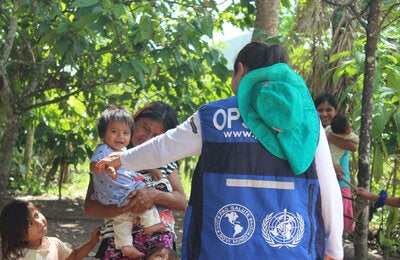
Washington, Nov. 22, 2017 (PAHO/WHO) - Health services can take specific steps to respond to violence against women and help prevent its future occurrences, if they are equipped with the tools and training they need.
These are the conclusions of a new manual being issued by the World Health Organization and the Pan American Health Organization for the International Day of Elimination of Violence against Women, observed Nov. 25. The document, "Strengthening health systems to respond to women subjected to intimate partner violence or sexual violence: A manual for health managers" builds on other tools to help health care systems provide compassionate and effective services to survivors that address the consequences of violence and help reduce its reoccurrence.
This is considered urgent because at least 1 of every 3 women aged 15 to 49 in Latin America and the Caribbean have experienced physical or sexual violence by a partner, according to Alessandra Guedes, PAHO's Regional Advisor on Family Violence. She noted that violence against women is a public health problem because it is associated with a number of significant health conditions, including anxiety, depression, suicide, unintended pregnancy, STI/HIV infection, unhealthy drinking, and others. It can also take many forms, including sexual harassment, physical/ emotional/ sexual violence by a partner, sexual violence by strangers and femicide, among others.
"Health systems and health care providers have a key role to play in mitigating the negative health consequences of violence, preventing reoccurrence of violence, and connecting survivors with services provided by other sectors such as justice and social welfare," Guedes said. "By providing quality and compassionate care to women who have experienced violence, as well as to their children, health care providers can also help prevent the impact of violence on the next generation," she added.
PAHO and WHO encourage five specific steps health providers can take to support women who have experienced violence" : "Listen closely, with empathy and no judgment; Inquire about their needs and concerns; Validate their experiences. Show you believe and understand; Enhance their safety; Support them to connect with additional services." These form the mnemonic "Lives."
The organizations have developed several evidence-based tools to strengthen health care providers' abilities and health systems' capacity to respond to women who have experienced violence, which are available online. These include:
- Responding to intimate partner violence and sexual violence against women: WHO clinical and policy guidelines
- Health care for women subjected to intimate partner violence or sexual violence: A clinical handbook
- Strengthening health systems to respond to women subjected to intimate partner violence or sexual violence: A manual for health care providers
- Responding to children and adolescents who have been sexually abused: WHO clinical guidelines
Training curricula for health care providers on how to identify and provide care to women who have experienced intimate partner or sexual violence (Due in 2018)
Although some progress has been made in preventing violence against women in the Americas, there is still "limited recognition of violence as a public health issue that imposes a significant burden for countries," health ministers from throughout the Americas heard at the Pan American Sanitary Conference in September. "Few resources, financial or human, are allocated to these areas of work," the health ministers were told. To improve the situation, measures should be taken to continue advocating for the recognition of violence against women as a public health priority and for increased investment by governments in its prevention across the life course, the report to them said.
PAHO has intensified its cooperation with countries to prevent violence against women and children, developing tools, strengthening networks and coalitions, building capacities in the countries, and improving the availability of data.
Countries have agreed in regional and global plans of action to implement strategies that will strengthen the capacity of health systems to respond to survivors of violence against women. Essential actions to prevent and respond to violence against women include collecting data about prevalence, risk factors and consequences of violence and raising awareness of violence against women as a public health problem.
Public health strategies can also be used to change social norms and behaviors linked to violence, and to provide early intervention for families at risk, such as home visitation and parenting programs. Comprehensive care to survivors of violence that can mitigate consequences of violence and prevent re-occurrence covers early identification, acute care, appropriate sexual and reproductive health services, danger assessment, safety planning, mental health care, and referral to legal and social support services.
Countries should also continue the actions recommended in regional and global strategies and plans of action, and work to achieve the violence-related targets of the 2030 Agenda for Sustainable Development, the report concluded.
Sustainable Development Goal 5 calls to "Eliminate all forms of violence against all women and girls in the public and private spheres, including trafficking and sexual and other types of exploitation."
Links
- Strategy and Plan of Action on Strengthening the Health System to Address Violence against Women
- Strengthening health systems to respond to women subjected to intimate partner violence or sexual violence: A manual for health managers
- PAHO Violence webpage



